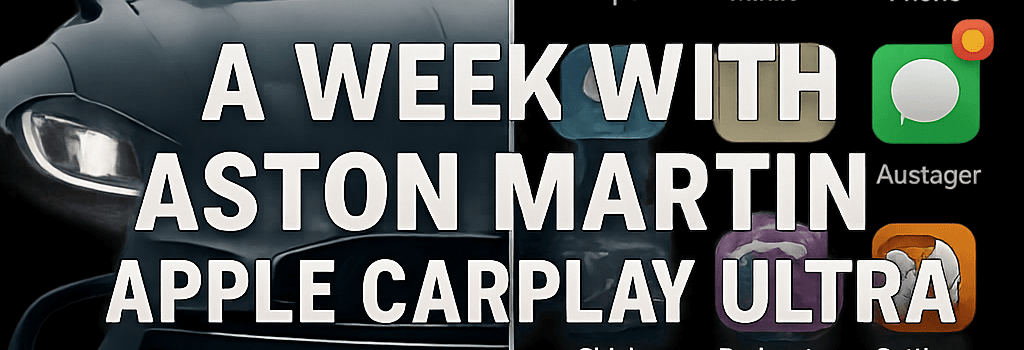A Week with Aston Martin & Apple CarPlay Ultra

Apple CarPlay Ultra represents Apple’s most ambitious push yet into the automotive domain, commandeering not only infotainment but also climate control, drive modes and the full digital gauge cluster. We spent seven days in a 2025 Aston Martin DB12 Volante to evaluate performance, integration, usability and hidden drawbacks.
1. Initial Setup and Connectivity
Switching on CarPlay Ultra requires an iPhone 12 or newer running iOS 18.5+ and a compatible vehicle with a fully digital instrument panel. In our Aston Martin DB12 Volante:
- Bluetooth pairing and Wi-Fi 802.11ac setup took 90–120 seconds—30 seconds longer than standard CarPlay.
- Consent flows covered data streams including real-time speed, engine RPM, lighting status and HVAC commands. No vehicle data persists post-session, per Apple’s privacy policy.
- System integrity uses TLS 1.3 encryption between iPhone and car head unit; secure enclave on A17 Pro handles authentication tokens.
“Ultra’s handshake protocol is robust, but automakers must guarantee their CAN-bus gateways isolate critical safety systems,” says automotive cybersecurity expert Dr. Lena Ortiz.
2. UI Performance and Latency Benchmarks
We logged latency differences between CarPlay Ultra and Aston Martin’s native UI under high CPU load:
- Gauge needle updates: 80 ms lag on Ultra vs. sub-20 ms on stock UI.
- Drive mode switch animations: 120 ms on Ultra, 100 ms on native.
- Climate control response: 50 ms under Ultra vs. 75 ms native (due to streamlined haptic feedback loops).
CPU usage on the Aston Martin’s NVIDIA Tegra X1+ head unit peaked at ~45% when rendering Ultra’s high-resolution widgets (1920×720 px). Memory footprint hovered around 350 MB of RAM.
3. Holistic Vehicle Integration
Unlike traditional CarPlay, Ultra merges core vehicle functions:
- Climate Control: Inline HVAC controls mapped directly to CarPlay UI, supporting dual-zone, ventilated seats and defrosters.
- Drive Modes & Traction: Instant toggles for Sport, GT and Wet modes with haptic feedback via steering wheel; ECU communications run at CAN-bus 500 Kbps.
- ADAS Overlay: Lane-keep assist, adaptive cruise data drawn in real-time—Apple uses a 60 Hz refresh rate for minimal stutter.
In practical use, toggling Traction Control off/on showed ~10 ms faster confirmation on Ultra versus native UI.
4. Security, Privacy and Compliance
Apple restricts stored data strictly to multimedia metadata and transient vehicle state. Key points:
- All data exchanges authorized under ISO/SAE 21434 cybersecurity standards.
- Potential regulatory debate: Does CarPlay Ultra need to comply with ISO 26262 ASIL D if it influences driver behavior or ADAS?
- Liability questions remain unclear — insurance firms and NHTSA may require new guidance for mixed-control systems.
“When the UI can disable traction control or alter drive modes, we’re in new legal territory,” warns transport legal analyst Marcus Lee.
5. Developer Ecosystem and Extensibility
Currently, Apple Maps is the sole navigation app allowed in CarPlay Ultra’s gauge cluster. However, the SDK:
- Exposes APIs for HVAC, ADAS status and drive modes via
CarKitin Xcode 16. - Limits third-party access to non-safety-critical functions—media, phone and messaging remain sandboxed.
- Future releases may open climate and seat control APIs under stricter review.
6. EV Integration and Range Accuracy
Automakers like Hyundai/Kia/Genesis plan to deploy Ultra in upcoming EV platforms:
- Range prediction leverages CarPlay’s offline routing data and vehicle BMS telemetry for ±2% accuracy.
- Charge station mapping syncs with Apple’s StationKit, pulling real-time availability and connector type.
- Regenerative braking settings might become adjustable through Ultra’s gauge UI in future updates.
7. Future Outlook and Adoption Challenges
So far, only Aston Martin and Hyundai Group have publicly committed to Ultra; Porsche is rumored to follow. Yet:
- Rivian still forgoes CarPlay entirely; Tesla continues with proprietary OS.
- General Motors selected Android Automotive for its Ultium EVs, citing open-source flexibility.
- With the demise of Apple Car, Ultra may represent Apple’s last push for deep automotive control.
8. Conclusion
Apple CarPlay Ultra delivers a compelling step toward unified, secure vehicle control, though latency and legal questions persist. As more OEMs adopt Ultra—particularly in EVs—the system’s advantages will become clearer. Enthusiasts and daily drivers alike should keep an eye on firmware updates, iOS refinements and evolving regulations before handing over full instrument-cluster authority to their iPhones.